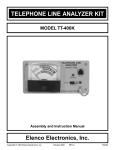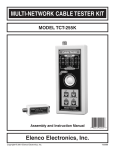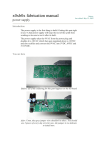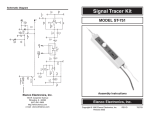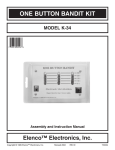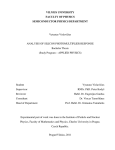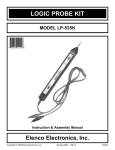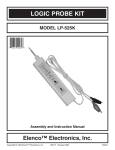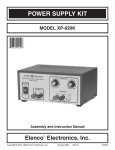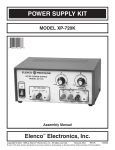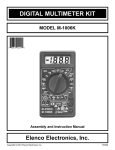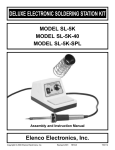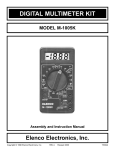Download Elenco Electronics AK-520 Instruction manual
Transcript
STROBE LIGHT KIT MODEL AK-520 Assembly and Instruction Manual Elenco Electronics, Inc. Copyright © 1994 Elenco Electronics, Inc. Revised 2002 REV-K 753018 PARTS LIST If you are a student, and any parts are missing or damaged, please see instructor or bookstore. If you purchased this strobe light kit from a distributor, catalog, etc., please contact Elenco Electronics (address/phone/e-mail is at the back of this manual) for additional assistance, if needed. RESISTORS Qty. 1 2 1 1 Symbol R1 R2, R4 R3 VR1 Value 200W 5% 1/4W 1MW 5% 1/4W 2MW 5% 1/4W 2MW Potentiometer Color Code red-black-brown-gold brown-black-green-gold red-black-green-gold Part # 132000 171000 172000 192731 CAPACITORS Qty. 1 2 1 1 1 Symbol C5 C1, C3 C6 C4 C2 Description .033mF 10% 250V Mylar (333) .1mF 10% 100V Mylar (2A104K) .1mF 10% 400V Mylar (2G104K) .47mF 10% 250V Mylar (474) 470mF 10V Electrolytic (Lytic) Part # 243319 251017 25102A 254717 284743 SEMICONDUCTORS Qty. 1 1 1 1 Symbol D2 D1 Q1 SCR Description 1N4004 Diode 1N4148 Diode 2N3904 Transistor T106D1 / C106D1 SCR Part # 314004 314148 323904 3606D1 Qty. 1 1 1 1 1 1 1 1 1 1 Description Part # Transformer (T1) 440008 PC Board 517024 Switch DPDT (SW1) 541107 Neon Bulb (NEON) 585020 Flash Tube/Trigger Assembly (T2) 586005 Battery Holder 590072 Bottom Case 62PX2GB Knob 622009 Top Panel 623107 Screw 2-56 x 5/8” Phillips 641277 MISCELLANEOUS Qty. 4 2 1 1 1 1 1 1 15” 1 Description Screw 4 x 1/2” Phillips Screw 2 x .4 x 5mm Phillips Nut Hex 7mm Nut 2-56 Hex Flat Washer 8mm Lockwasher 5/16” Lockwasher #2 INT Tape Double-Sided Wire 22ga. Topcoat Red Solder PARTS IDENTIFICATION Resistor Capacitors Transistor Transformer Flash Tube/ Trigger Diode Mylar Electrolytic Potentiometer SCR Switch or -1- Neon PC Board Part # 642465 643148 644101 644201 645101 646101 646200 740020 814200 9ST4 IDENTIFYING RESISTOR VALUES Use the following information as a guide in properly identifying the value of resistors. BAND 1 1st Digit Color Black Brown Red Orange Yellow Green Blue Violet Gray White Multiplier BAND 2 2nd Digit Digit 0 1 2 3 4 5 6 7 8 9 Color Black Brown Red Orange Yellow Green Blue Violet Gray White Resistance Tolerance Color Multiplier Black 1 Brown 10 Red 100 Orange 1,000 Yellow 10,000 Green 100,000 Blue 1,000,000 Silver 0.01 Gold 0.1 Digit 0 1 2 3 4 5 6 7 8 9 Color Silver Gold Brown Red Orange Green Blue Violet Tolerance +10% +5% +1% +2% +3% +0.5% +0.25% +0.1% BANDS 1 2 Multiplier Tolerance IDENTIFYING CAPACITOR VALUES Capacitors will be identified by their capacitance value in pF (picofarads), nF (nanofarads), or mF (microfarads). Most capacitors will have their actual value printed on them. Some capacitors may have their value printed in the following manner. The maximum operating voltage may also be printed on the capacitor. Multiplier For the No. 0 1 2 3 Multiply By 1 10 100 1k 4 5 8 10k 100k 0.01 9 0.1 Note: The letter “R” may be used at times to signify a decimal point; as in 3R3 = 3.3 10mF 16V First Digit Second Digit Multiplier 103K Tolerance 100V The letter M indicates a tolerance of +20% The letter K indicates a tolerance of +10% The letter J indicates a tolerance of +5% Maximum Working Voltage The value is 10 x 1,000 = 10,000pF or .01mF 100V METRIC UNITS AND CONVERSIONS Abbreviation p n m m – k M Means Pico nano micro milli unit kilo mega Multiply Unit By .000000000001 .000000001 .000001 .001 1 1,000 1,000,000 Or 10-12 10-9 10-6 10-3 100 103 106 1. 1,000 pico units = 1 nano unit 2. 1,000 nano units = 1 micro unit 3. 1,000 micro units= 1 milli unit 4. 1,000 milli units = 1 unit 5. 1,000 units = 1 kilo unit 6. 1,000 kilo units = 1 mega unit -2- INTRODUCTION Have you ever seen a lightning flash and wonder how the light was produced? This strobe light kit not only explains how a high voltage discharge produces light, but reproduces those bolts of lightning in a small glass tube. Even more amazing is the fact you will be able to control the moment each flash occurs with a trigger circuit. Strobe lights are used to stop motion by adjusting the trigger rate to the speed of a moving object. They are also used to produce light for photography at the moment the camera shutter is opened. In the text that follows, mechanical analogies are used to help explain certain processes that are otherwise difficult to visualize. THEORY OF OPERATION WHAT IS A GAS? The amount of energy it takes to create an ion is measured in electron volts. Table 1 shows the energy needed to produce ions for different gases. As you can see, Xenon requires much less energy than Neon to produce ions. If the glass tube in your kit contained Neon, the amount of energy needed to ionize the gas would be 1.87 times greater. This would shorten the life of the batteries by using almost twice the energy for each flash. It is a law of nature that opposite charges attract each other and similar charges repel. When a gas molecule is turned into a positive ion, it is attracted to a negative charge. The a positive gas ion is placed in a strong electric field, it will rapidly accelerate toward the negative plate. As it moves, it will strike other gas molecules, knocking electrons free and creating more positive ions. These newly created ions will be attracted by the negative plate, accelerate and create even more positive ions (see Figure 3). The avalanche process will continue until all of the gas in the tube is ionized allowing a large current to flow through the tube and collapse the electric field. As the electrons are knocked about during the ionization process, Gas Ionization they release small Energy packets of energy called photons that Helium 24.5 radiate from the Neon 21.5 tube. The human Nitrogen 16.7 eye perceives this Hydrogen 15.9 burst of photons as Argon 15.7 a brilliant flash of Carbon Monoxide 14.2 light. Oxygen 13.5 Krypton 13.3 Water Vapor 13.2 Xenon 11.5 Mercury 10.4 All matter is composed of atoms arranged in patterns called molecules. In a solid, these molecules are held in place and cannot move about easily. In a liquid, the molecules move freely, but are still loosely bound to each other. In a gas, the molecules are separated by great distances and bounce about like ping-pong balls in a large box. The molecules of a gas are not bound to each other and will dissipate into the surrounding space if released from their container. These different states of matter are shown in Figure 1. Figure 1 Solid Liquid Gas The glass tube in your strobe light kit is filled with a rare gas called Xenon. This gas is used because it is easy to ionize. WHAT IS AN ION? Gas atoms have no electronic charge on them in their normal state. There are just as many positively charged protons as there are negatively charged electrons. Therefore, the net charge on the atom is zero. If, however, a negatively charged electron is removed from one of the atoms, the atom is left with a positive charge and it is called a positive ion. This creation of ions is shown in Figure 2. Figure 2 Protons Electrons Normal Gas Positive Ion Molecule Table 1 Negative Ion -3- pendulum in a grandfather clock. Once the pendulum is started in motion, it will use only a small amount of energy from the main spring to keep it swinging at the exact same frequency. It is this stable frequency rate that sets the time accurately. If the weight is moved up the stick, the frequency increases. This is called tuning the frequency of the pendulum. In electronics, an oscillator circuit also has tunable elements. The inductor in a tuned electrical circuit is equivalent to the length of the pendulum (see Figure 6). Figure 3 Radiated Energy Gas Molecule Positive Ion Negative Charge on Plate GENERATING AN ELECTRIC FIELD In order to ionize the Xenon gas in the glass tube, the 3 volts DC at the battery must be transformed into hundreds of volts DC. One of the electronic devices used to “step up” voltages is called a transformer. Transformers, however, only work with AC voltages. You can think of a transformer as a lever similar to the one shown in Figure 4. A small movement on the short end of the lever will produce a large swing on the other end. Since the lever does not create energy, the power on one end must equal the power on the other end. Therefore, the force times the distance on the short end must equal the force times the distance on the other end (as shown in Figure 4). Figure 6 MAKING THE FIRST ION 2 Inches Weight = 2 lbs. When the electric field is placed across the Xenon tube nothing happens because there are no ions in the tube to start the avalache process. A second transformer is used to generate a very high voltage spike on a piece of wire placed along side the tube. This transformer is called the trigger transformer since it “triggers” the avalanche process by forcing a few ions to be produced momentarily in the tube. This process is shown in Figure 7. 20 Inches 2 In. x 20 lbs. = 20 in. x 2 lbs. Short Side Long Side Just like the lever, the transformer must have a moving voltage (AC) to work. If the movement on the short end of the lever equals zero, the movement on the long end will also be zero. Likewise, if DC is applied to one side of a transformer, the output on the other side will be zero. Since the transformer cannot create energy, the power on one side must equal the power on the other side. Electrical power is measured by multiplying the voltage times the current (V x I). Figure 5 shows the method used to transform the 3 volts from the battery to 200 volts needed for a strong electric field. = Figure 7 Positive Ion Wire with High Voltage Spike Electron Freed by High Voltage Spike 300V x .003A DC to AC Converter 300 Volts DC (Oscillator) 3V Battery L = Inductance By changing the position of the iron core in the inductor, the inductance can be changed to tune the oscillator to a desired radio frequency, just like changing the weight of the pendulum would change its frequency. Figure 4 3V x .3A C = Capacitance L Electronic Tuned Circuit in Oscillator Weight Force of 20 lbs. Figure 5 C Length Transformer Diode & Capacitor Converts AC to DC An oscillator is an electronic circuit similar to the -4- Tube Filled with Xenon THEORY OF OPERATION produce the avalanche process, as shown in Block 2. After the high voltage is generated, a trigger pulse is used to start the avalanche process (Block 3). Once the gas in the flash tube (Block 4) is ionized, the resistance of the tube drops and a large current flows through the tube causing the high voltage to collapse. The gas in the tube returns to its normal state (not ionized) and the process starts over. A block diagram is used to break down a system into sub-systems that are easier to explain. All strobe lights will have the blocks shown in Figure 8. The power supply, Block 1, can be either an AC (Alternating Current) or DC (Direct Current) source of electrical power. When a low voltage DC source is used, a battery for instance, the voltage must be “stepped up” to the proper high voltage required to Figure 8 1 POWER SUPPLY 2 GENERATE HIGH DC VOLTAGE 3 TRIGGER CIRCUIT 4 FLASH TUBE BLOCK 3 - The trigger circuit uses a neon light to fire an SCR (Silicon Controlled Rectifier). The SCR acts like a switch discharging capacitor C4 through the primary of transformer T2. A high voltage spike is produced on the secondary of T2. By using a piece of wire, this trigger voltage is placed close to the glass tube containing the xenon gas. BLOCK 1 - Since the power supply in this kit is a battery, it is a DC source. The low DC voltage must be converted to a high DC voltage required by the flash tube. BLOCK 2 - Figure 5 shows a fundamental high voltage generator. In this kit, a transistor is used for an oscillator (Q1 on schematic drawing shown on page 10). Q1 drives the primary of transformer T1 and the secondary also steps up the voltage needed to flash the xenon tube. BLOCK 4 - The flash tube consists of a hollow glass tube filled with Xenon gas and sealed at each end with a metal cap. Wires are connected to each of the metal caps. When a high voltage is placed on one cap and the other cap is grounded, a strong electric field will appear across the tube. -5- CONSTRUCTION Introduction The most important factor in assembling your AK-520 Strobe Light Kit is good soldering techniques. Using the proper soldering iron is of prime importance. A small pencil type soldering iron of 25 - 40 watts is recommended. The tip of the iron must be kept clean at all times and well tinned. Safety Procedures • Wear eye protection when soldering. • Locate soldering iron in an area where you do not have to go around it or reach over it. • Do not hold solder in your mouth. Solder contains lead and is a toxic substance. Wash your hands thoroughly after handling solder. • Be sure that there is adequate ventilation present. Assemble Components In all of the following assembly steps, the components must be installed on the top side of the PC board unless otherwise indicated. The top legend shows where each component goes. The leads pass through the corresponding holes in the board and are soldered on the foil side. Use only rosin core solder of 63/37 alloy. DO NOT USE ACID CORE SOLDER! What Good Soldering Looks Like Types of Poor Soldering Connections A good solder connection should be bright, shiny, smooth, and uniformly flowed over all surfaces. 1. Solder all components from the copper foil side only. Push the soldering iron tip against both the lead and the circuit board foil. 1. Insufficient heat - the solder will not flow onto the lead as shown. Soldering Iron Component Lead Foil Soldering iron positioned incorrectly. Circuit Board 2. 3. 4. Apply a small amount of solder to the iron tip. This allows the heat to leave the iron and onto the foil. Immediately apply solder to the opposite side of the connection, away from the iron. Allow the heated component and the circuit foil to melt the solder. Allow the solder to flow around the connection. Then, remove the solder and the iron and let the connection cool. The solder should have flowed smoothly and not lump around the wire lead. Rosin 2. Insufficient solder - let the solder flow over the connection until it is covered. Use just enough solder to cover the connection. Soldering Iron Solder Foil Solder Gap Component Lead Solder 3. Excessive solder - could make connections that you did not intend to between adjacent foil areas or terminals. Soldering Iron Solder Foil 4. Solder bridges - occur when solder runs between circuit paths and creates a short circuit. This is usually caused by using too much solder. To correct this, simply drag your soldering iron across the solder bridge as shown. Here is what a good solder connection looks like. -6- Soldering Iron Foil Drag ASSEMBLE COMPONENTS TO THE PC BOARD C5 - .033mF (333) Mylar Cap. C6 - .1mF (2G104K) Mylar Cap. Wire 1” - Cut a 1” wire and strip both ends. Solder one end to the PC board marked (+). SCR - T106D1 SCR (Fig. D) C4 - .47mF (474) Mylar Cap. R3 - 2MW 5% 1/4W Resistor (red-black-green-gold) D2 - 1N4004 Diode (Fig. B) Wire 1” - Cut a 1” wire and strip both ends. Solder one end to the PC board marked (–). R4 - 1MW 5% 1/4W Resistor (brown-black-green-gold) C3 - .1mF (2A104K) Mylar Cap. R2 - 1MW 5% 1/4W Resistor (brown-black-green-gold) R1 - 200W 5% 1/4W Resistor (red-black-brown-gold) NEON - Neon Lamp T1 - Transformer D1 - 1N4148 Glass Diode (Fig. B) VR1 - 2MW Potentiometer Cut three 3” red wires and solder them to the PC board marked 1-2-3. Then solder the other ends to the 2MW pot as shown. C2 - 470mF Lytic Capacitor (Fig. C) Cut the tab off of the 2MW pot. Q1 - Transistor 2N3904 (Fig. A) C1 - .1mF (2A104K) Mylar Cap. BATT - Battery Wires Solder the black battery holder wire to the BATT (–) Hole marked on the PC board. Black (–) Solder the red battery holder wire to the left lug of the switch. Red (+) Solder the 2” red wire to the BATT (+) hole on the PC board. Then, solder the other end to the middle lug of the switch. Switch Cut off tab Figure B Figure A Figure C Diodes have polarity. Mount them with the band in the correct direction, as shown on the top legend. Mount the transistor onto the PC board with the flat side in the same direction as shown on the top legend. Glass Electrolytics have a polarity marking indicating the (–) lead. The PC board is marked to show the lead position. With Beveled Edge Metal Backing UNITS IN INCHES 2 (+) Figure D PC Board Marking 1 (–) Mount the SCR in the same direction as marked on the PC board. Epoxy ¼ ½ Polarity Marking PC Board Marking Band 0 VR1 - 2MW Potentiometer 3 4 Use this ruler to measure the wires when cutting them to their required lengths. -7- FINAL ASSEMBLY Wire from (–) Legend Side of PC Board Wire from (+) Insert Figure 9 1 Foil Side of PC Board T2 (See Figure 9) Insert the flash tube assembly and solder T2 to the PC board as shown in Figures 10-12. Push in until it snaps. Figure 10 Figure 11 Back Cover Figure 12 Figure 13 2-56 Nut 2 Solder the wires from the (+) and (–) points on the PC board to the flash tube (see Figure 12). Lockwasher 3 Assemble the PC board, switch and pot to the front panel as shown. 4 Remove the backing on both sides of the double-sided tape and apply it to the back of the battery holder. Now, place the battery holder inside of the case as shown in Figure 14. Insert three “AA” size (alkaline only) batteries into the battery holder. Double-sided Tape Battery Holder Front Cover 8mm Flat Washer 5/16” Lockwasher 2-56 x 5/8” Screw Top 7mm Hex Nut Figure 14 2 x 0.4 x 5mm Screws Note: Be sure that you place the battery holder at the bottom of the back cover as shown in Figure 14. Also, make sure that the three positive (+) battery terminals are pushed up against the battery holder contacts. -8- Place the lid onto the case and secure it with four 4 x 1/2” screws (see Figure 15). Knob - Turn the shaft on the pot counter-clockwise all of the way. Install the knob with the line pointing in the direction as shown in Figure 16. Strobe Light Kit AK-520 OFF ON FLASH RATE 4 x 1/2” Screws Figure 16 Figure 15 CAUTION: High voltage present on the PC board. DO NOT handle it while in operation! OPERATION 1. Turn the unit on and turn the knob to the desired flash rate. As you adjust the knob clockwise, the flash rate will increase. The maximum flash rate should be at the mid point. The maximum flash rate can be adjusted to approximately 4 times per second. TROUBLESHOOTING Consult your instructor or contact Elenco Electronics if you have any problems. DO NOT contact your place of purchase as they will not be able to help you. 1. One of the most frequently occurring problems is poor solder connections. Tug slightly on all of the parts to make sure that they are indeed soldered. 2. All solder connections should be shiny. Resolder any that are not. 3. Solder should flow into a smooth puddle rather than a round ball. Resolder any connection that has formed into a ball. 4. Have any solder bridges formed? A solder bridge may occur if you accidentally touch an adjacent foil by using too much solder or by dragging the soldering iron across adjacent foils. Break the bridge with your soldering iron. 5. Check the battery voltage with a voltmeter (4.5VDC). 6. Check the voltage across C4 for 250 - 350V. If less, then check the battery, R1, C1 - C3, Q1, D2 and/or T1. If greater, then check R2 - R4, VR1, Neon, SCR, C6, T2 and/or the flash tube. 7. If the Neon flashes but the strobe light doesn’t, then check the SCR, C6, T2, battery voltage and/or the flash tube. -9- GLOSSARY AC Voltage A voltage that varies, usually above and below zero volts, thus causing the current to alternate. Atom The smallest part into which matter can be divided and still maintain its identity. Avalanche An increase in moving particles due to sudden impact. Electric Field The force that exists when a difference in charge occurs. Electron A tiny negatively charged particle that rotates around the nucleus of an atom. Electron-volts A unit of energy equal to 1.602 x 10-19 joules. Energy Effective force. The capacity for doing work. Force The cause that changes bodies from a state of rest to motion or from motion to rest. Gas An air-like substance without definite shape or volume, tending to expand indefinitely when unconfined. One of the three forms in which matter can exist. Ion An electrically charged particle that enables the flow of electricity. Liquid One of the three forms in which matter can exist separately and still maintain the character of that substance. Neon A gaseous element, inert, colorless, and found in the atomosphere. Photons A unit of light measurement. Power The mechanical rate at which energy is exerted or work done. Proton The smallest unit of positive charge in an atom. Solid One of three forms in which matter can exist, having a definite volume and a definite shape. Transformer A device used for converting an alternating electric current from one voltage to another. Xenon A gaseous element which belongs to the group of inert gases. It occurs in air in minute traces. QUIZ 1. All matter is composed of atoms arranged in patterns called _______________. 2. In their normal state, the net charge on a molecule of gas is _______________. 3. When a molecule of gas is positively charged it is called a _______________. 4. Xenon requires less _______________ than Neon to produce ions. 5. A positive ion will accelerate toward a _______________ charged plate. 6. During the ionization and avalanche process, small packets of energy called _______________ radiate from the glass tube. 7. The _______________ is used to step-up an AC voltage. 8. Electrical power is measured by multiplying _______________ times _______________. 9. The _______________ transformer is used to produce the first ions. 10. A negative ion has on more _______________ than it has protons. Answers: 1. Molecules; 2. Zero; 3. Positive Ion; 4. Energy; 5. Negative; 6. Photons; 7. Transformer; 8. Voltage, Current; 9. Trigger; 10. Electron. -10- SCHEMATIC DIAGRAM Elenco Electronics, Inc. 150 W. Carpenter Avenue Wheeling, IL 60090 (847) 541-3800 http://www.elenco.com e-mail: [email protected] Technical Assistance Hotline: (800) 533-2441












